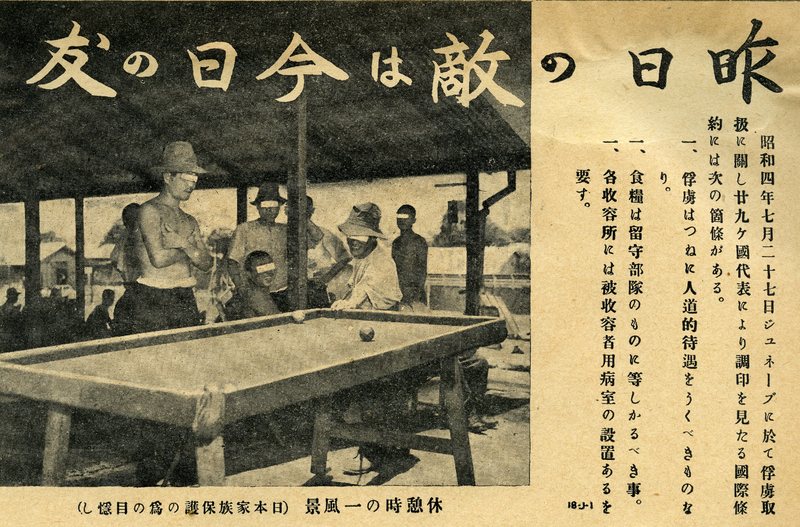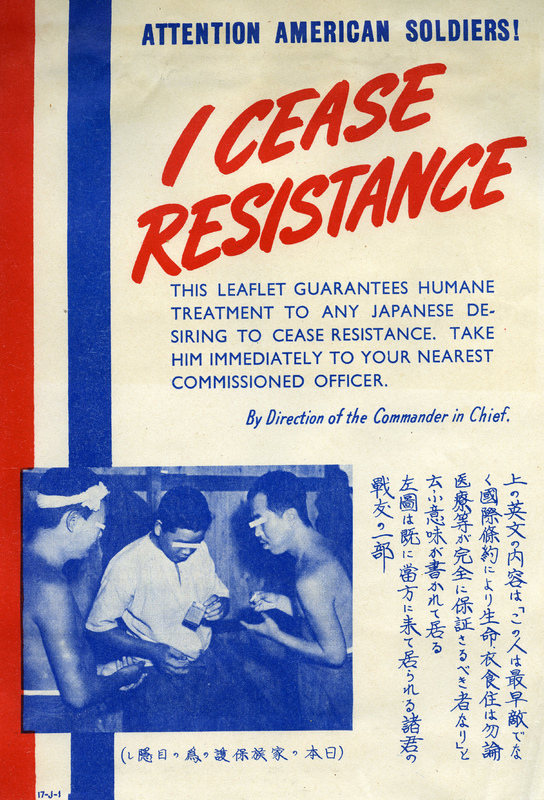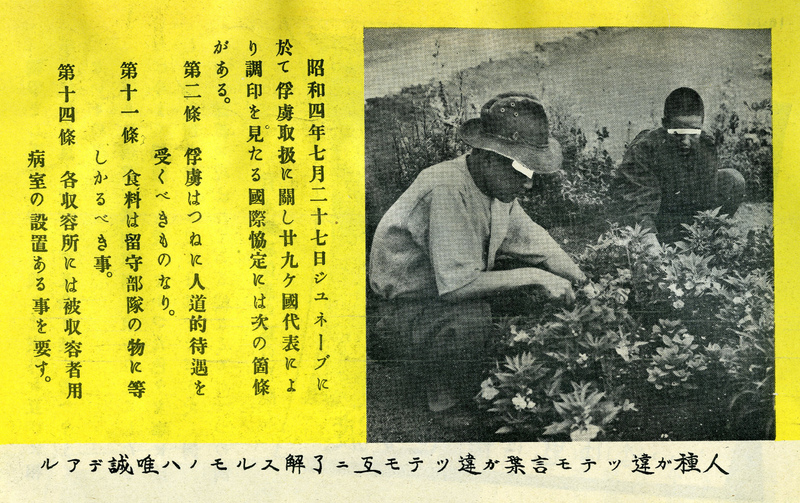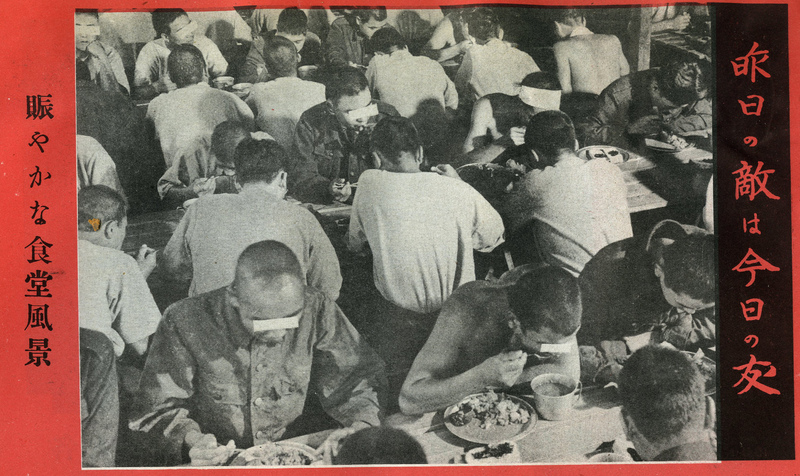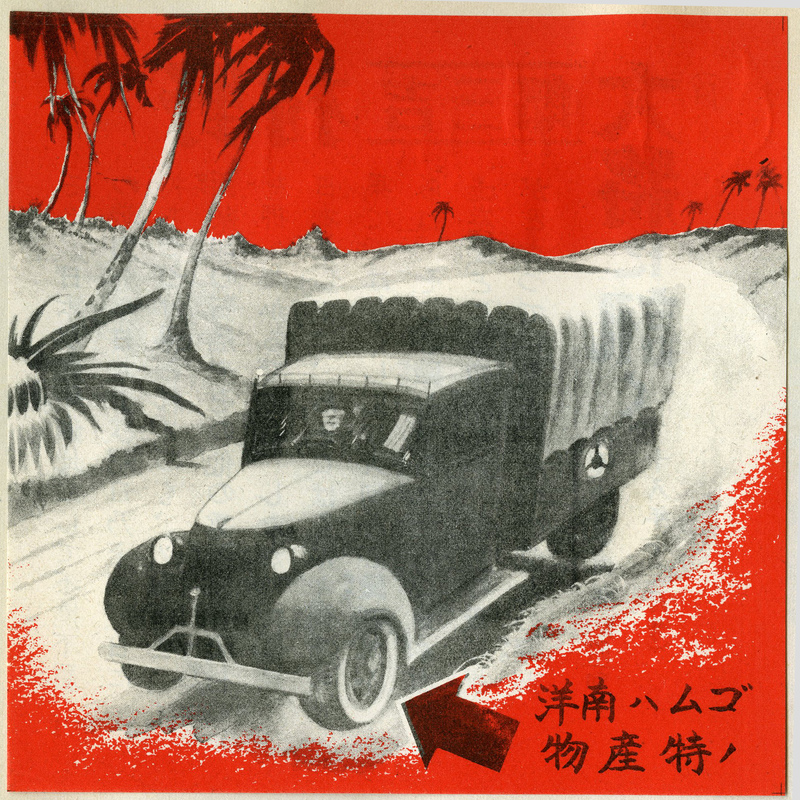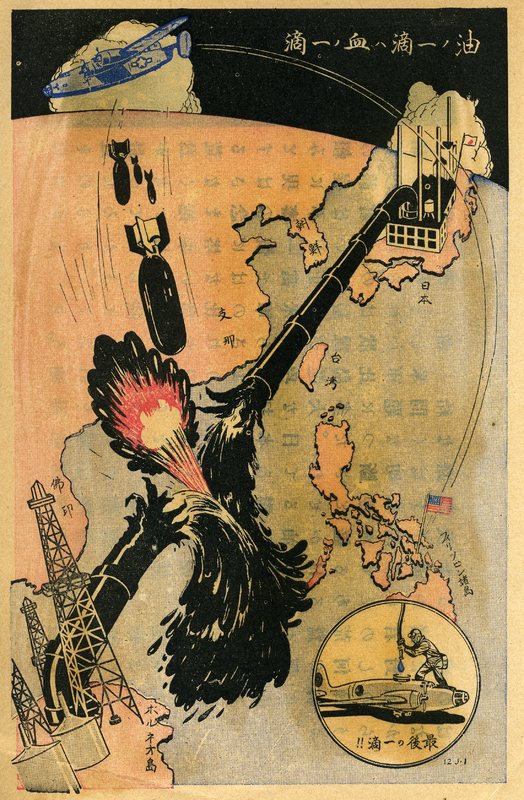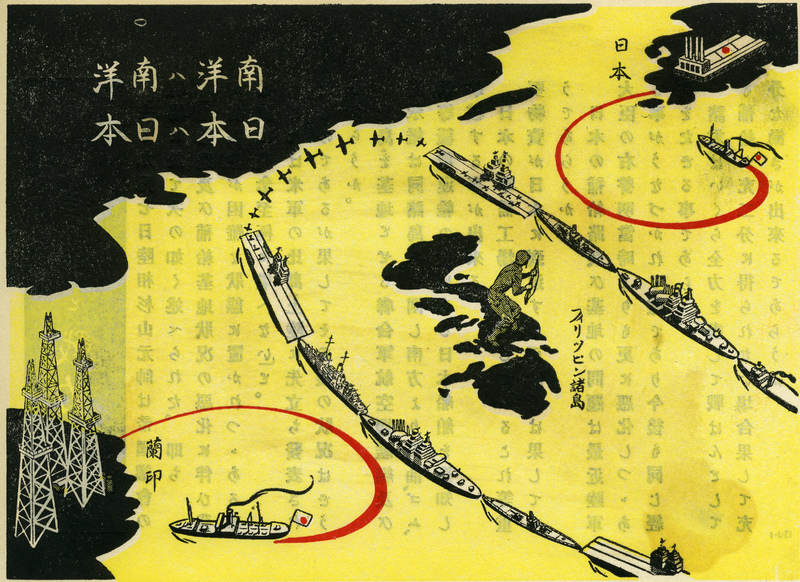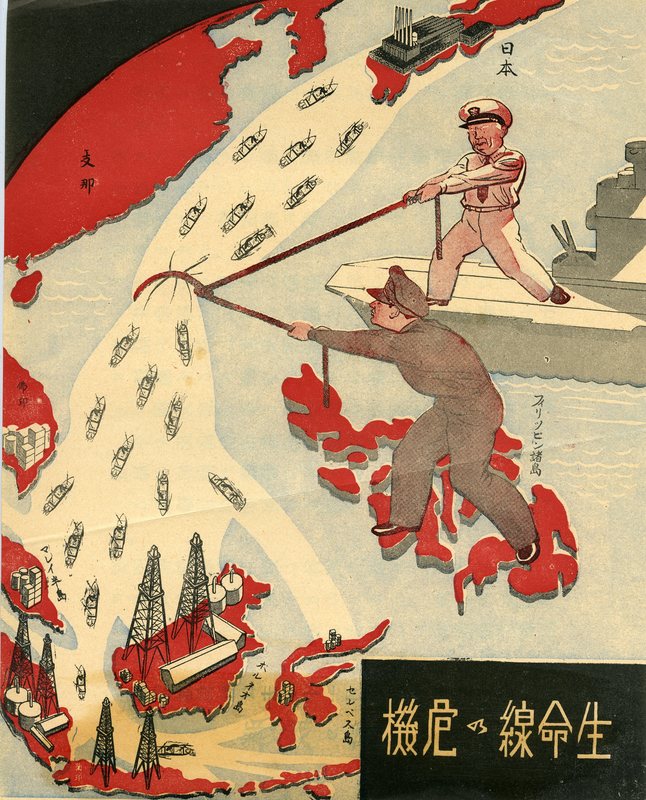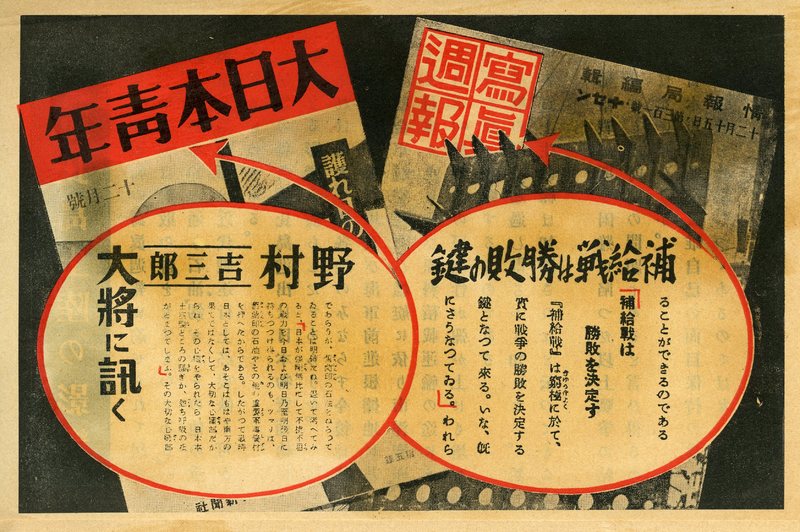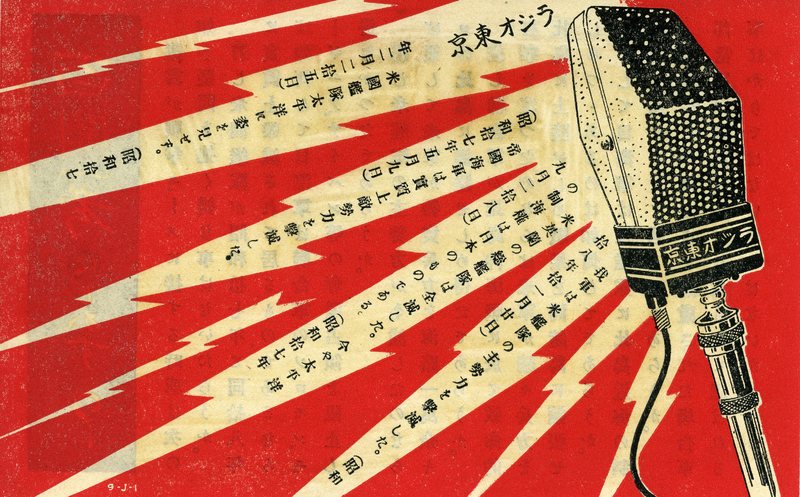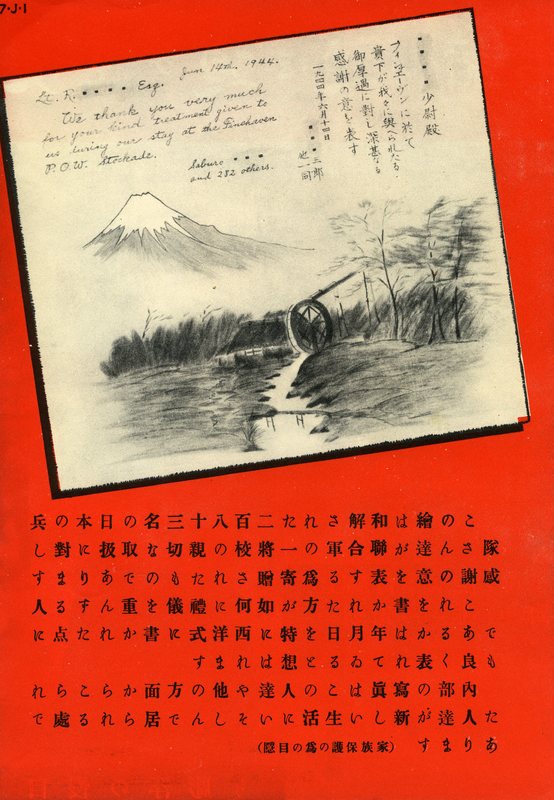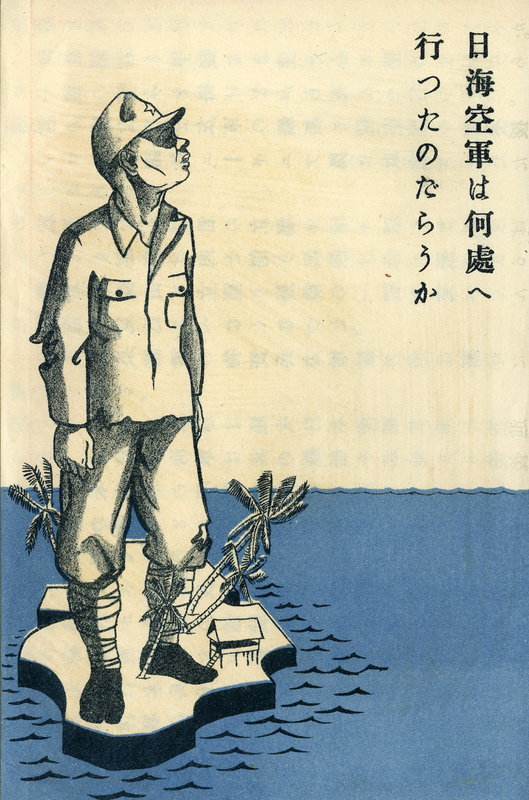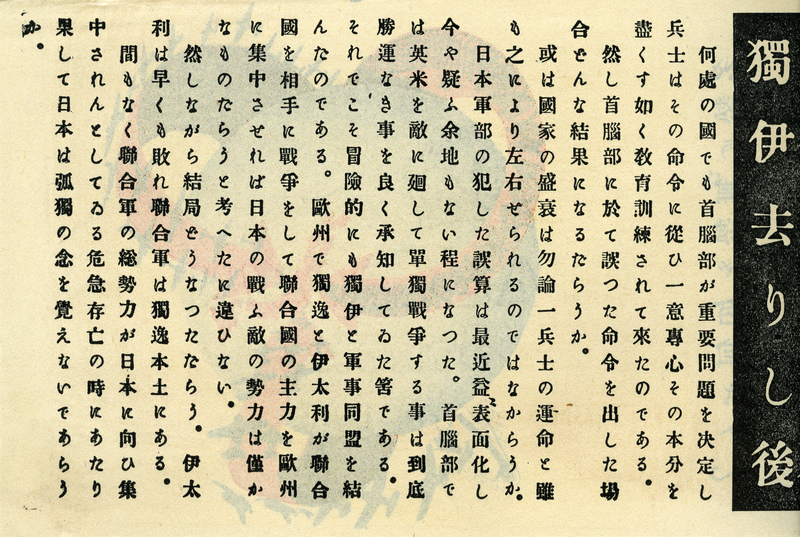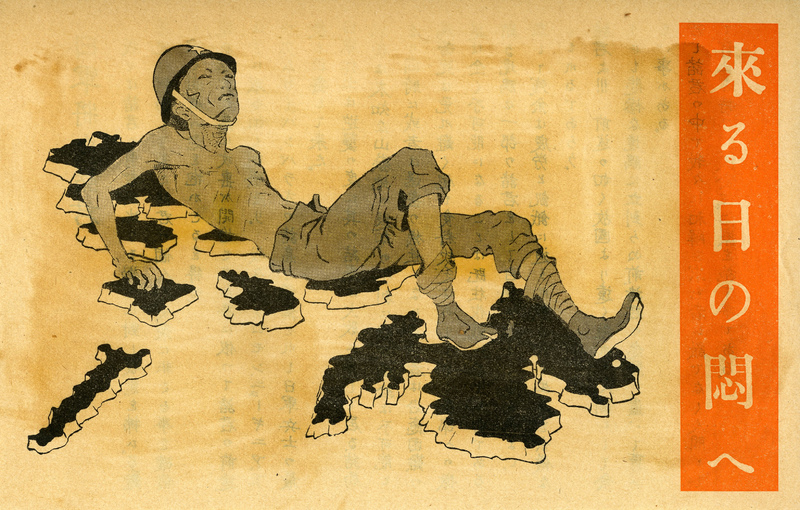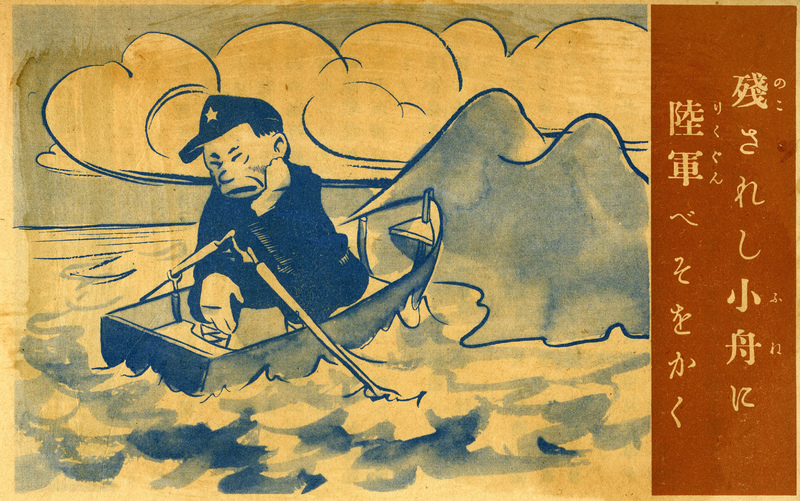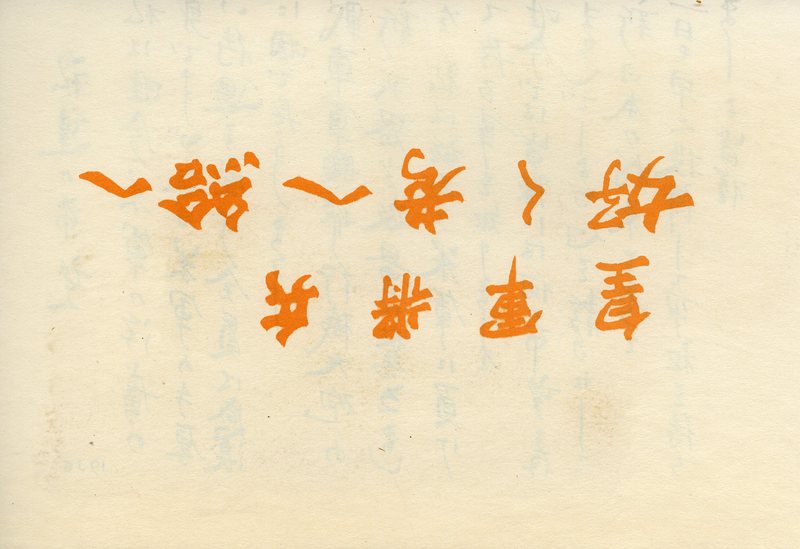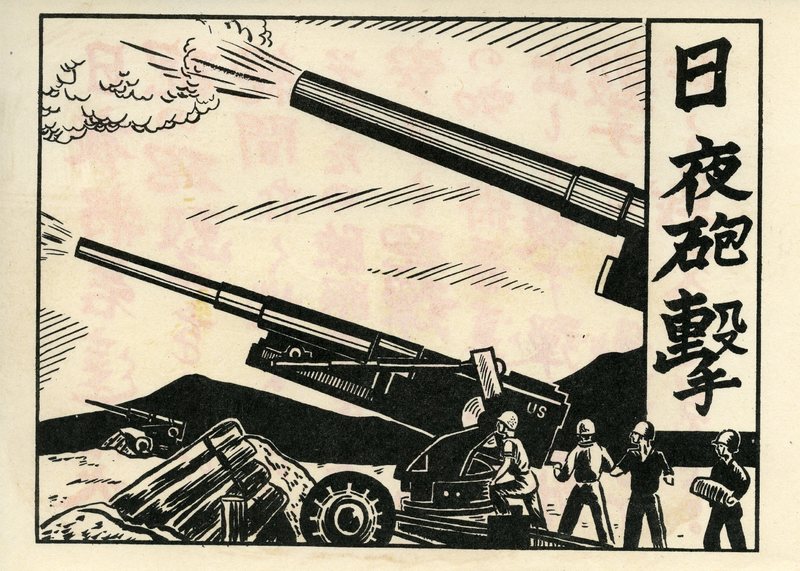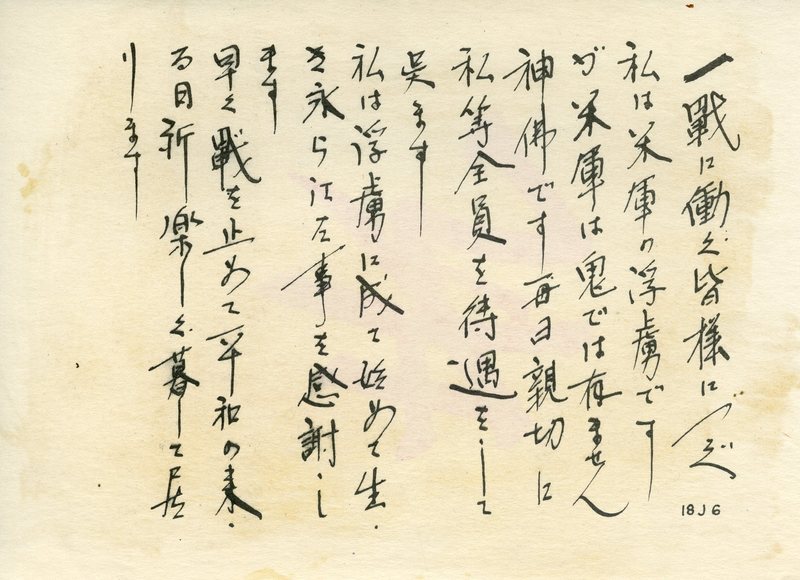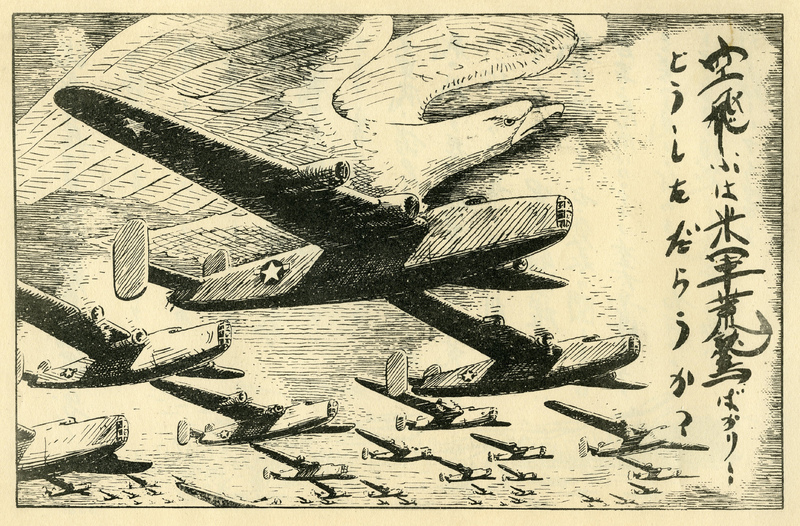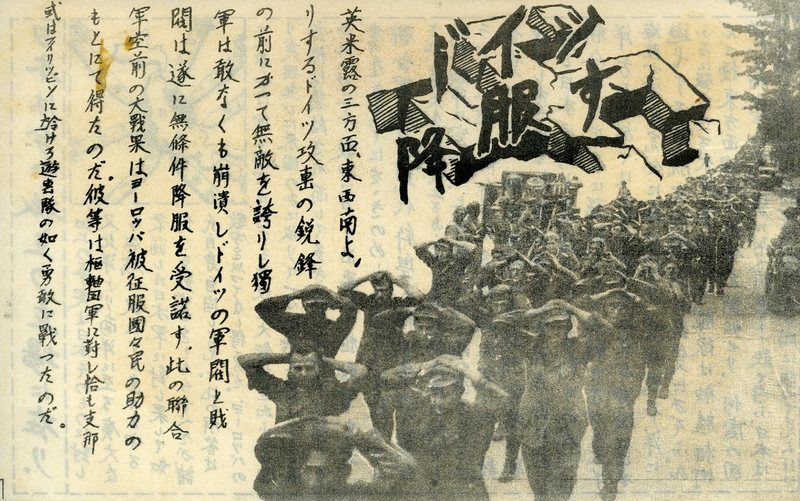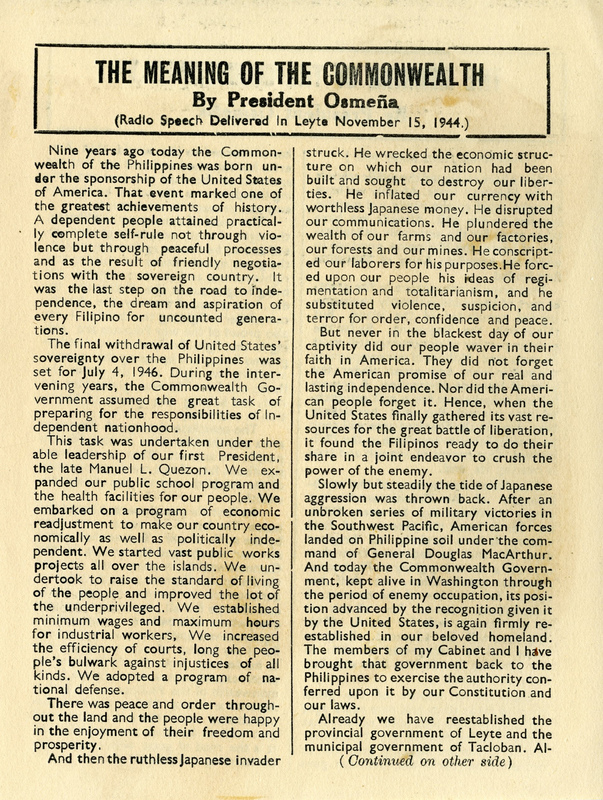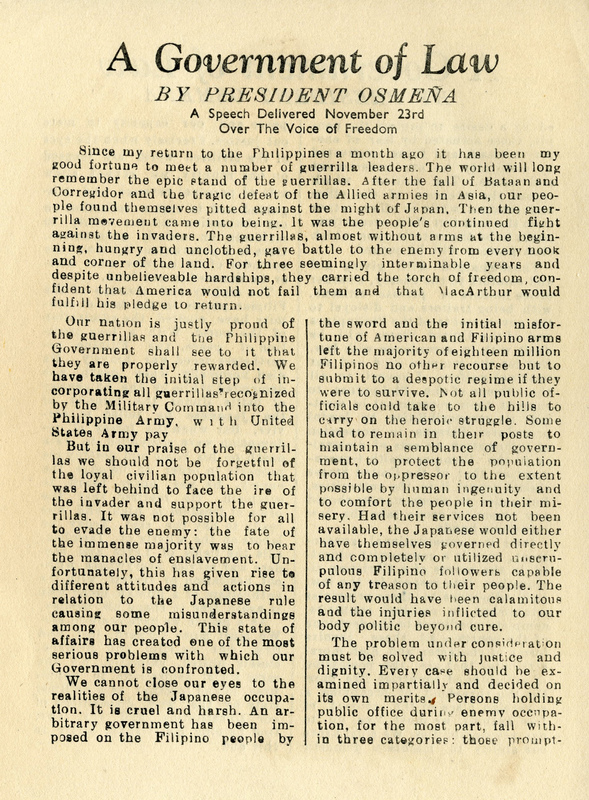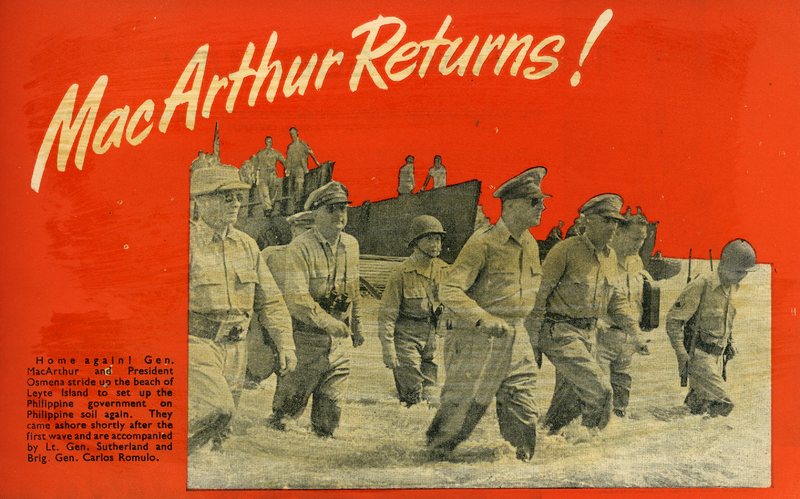Pacific University Archives DPLA
- Title
- Pacific University Archives DPLA
- Description
- An artificial set created to facilitate harvesting of metadata for dp.la.
Items
-
'Yesterday we were Enemies, Today we are Friends' propaganda leafletA propaganda leaflet issued by the Allied Forces during World War II after the return of General Douglas MacArthur to the Philippine Islands in 1944. The leaflets were probably airdropped to Japanese troops on the Philippine Islands soon after General MacArthur landed in October, 1944. One side of the leaflet features an image of Japanese prisoners of war playing a game of pool. The other side of the leaflet emphasizes the good treatment of Japanese prisoners of war in accordance to the International Law. It was meant to induce the surrender of Japanese troops by demonstrating that the Allied Forces would treat prisoners of war humanely according to the International Law. The leaflet is numbered '18J1'. It is accompanied by an official description and translation of the text into English. This is one item from a scrapbook of propaganda leaflets and related materials that was compiled by the Psychological Warfare Branch of the Allied Forces in the Southwest Pacific Area during World War II. The scrapbook belonged to Colonel Karl F. Baldwin of the United States Army, who helped establish the propaganda program. It contains approximately 200 pieces of propaganda, mostly in Japanese, that were intended for distribution in the Philippines, Japan, and other nearby areas.
-
'I Cease Resistance' propaganda leafletA propaganda leaflet issued by the Allied Forces during World War II after the return of General Douglas MacArthur to the Philippine Islands in 1944. The leaflets were probably airdropped to Japanese troops on the Philippine Islands soon after General MacArthur landed in October, 1944. It was meant to induce the surrender of Japanese troops by demonstrating the humane treatment troops will receive by the Allied Forces. It explains that prisoners of war will be treated humanely according to the articles of the International Law. The leaflet is numbered '17J1'. It is accompanied by an official description and translation of the text into English. This is one item from a scrapbook of propaganda leaflets and related materials that was compiled by the Psychological Warfare Branch of the Allied Forces in the Southwest Pacific Area during World War II. The scrapbook belonged to Colonel Karl F. Baldwin of the United States Army, who helped establish the propaganda program. It contains approximately 200 pieces of propaganda, mostly in Japanese, that were intended for distribution in the Philippines, Japan, and other nearby areas.
-
'Good Treatment of Prisoners' propaganda leafletA propaganda leaflet issued by the Allied Forces during World War II after the return of General Douglas MacArthur to the Philippine Islands in 1944. The leaflets were probably airdropped to Japanese troops on the Philippine Islands soon after General MacArthur landed in October, 1944. It features images of Japanese prisoners of war, depicting them eating and working in a garden. The leaflet list three articles from the International Law on the treatment of prisoners. It was meant to induce the surrender of Japanese troops by demonstrating that the Allied Forces would treat prisoners of war humanely according to the International Law. It is numbered '16J1'. The leaflet is accompanied by an official description and translation of the text into English. This is one item from a scrapbook of propaganda leaflets and related materials that was compiled by the Psychological Warfare Branch of the Allied Forces in the Southwest Pacific Area during World War II. The scrapbook belonged to Colonel Karl F. Baldwin of the United States Army, who helped establish the propaganda program. It contains approximately 200 pieces of propaganda, mostly in Japanese, that were intended for distribution in the Philippines, Japan, and other nearby areas.
-
'Good Treatment of Prisoners' propaganda leafletA propaganda leaflet issued by the Allied Forces during World War II after the return of General Douglas MacArthur to the Philippine Islands in 1944. The leaflets were probably airdropped to Japanese troops on the Philippine Islands soon after General MacArthur landed in October, 1944. It features photographs of Japanese prisoners of war. The leaflet states that Japanese prisoners are provided with food, clothing, shelter, medical care and recreation in accordance with the International Law. It was meant to induce surrender of Japanese troops by demonstrating the treatment troops would receive once they surrendered. The leaflet is numbered '15J1'. The leaflet is accompanied by an official description and translation of the text into English. This is one item from a scrapbook of propaganda leaflets and related materials that was compiled by the Psychological Warfare Branch of the Allied Forces in the Southwest Pacific Area during World War II. The scrapbook belonged to Colonel Karl F. Baldwin of the United States Army, who helped establish the propaganda program. It contains approximately 200 pieces of propaganda, mostly in Japanese, that were intended for distribution in the Philippines, Japan, and other nearby areas.
-
'Tools of War' propaganda leafletsA series of propaganda leaflets issued by the Allied Forces during World War II after the return of General Douglas MacArthur to the Philippine Islands. The leaflets were probably airdropped to Japanese troops on the Philippine Islands soon after General MacArthur returned in October, 1944. The series of leaflets stresses the importance of the natural resources that Japan receives from the South Seas. Without these resources Japan cannot win the war. The intent of the leaflet was to demoralize Japanese troops by pointing out their weaknesses, with the hope of inducing their surrender. The leaflets are numbered '14J1'. They are accompanied by an official description and translation of the text into English. This is one item from a scrapbook of propaganda leaflets and related materials that was compiled by the Psychological Warfare Branch of the Allied Forces in the Southwest Pacific Area during World War II. The scrapbook belonged to Colonel Karl F. Baldwin of the United States Army, who helped establish the propaganda program. It contains approximately 200 pieces of propaganda, mostly in Japanese, that were intended for distribution in the Philippines, Japan, and other nearby areas.
-
'Pipeline' propaganda leafletA propaganda leaflet issued by the Allied Forces during World War II after the return of General Douglas MacArthur to the Philippine Islands in 1944. The leaflets were probably airdropped on Japanese troops on the Philippine Islands soon after General MacArthur returned in October, 1944. It explains the importance of oil in the South Pacific for the Japanese. It states that the Americans have sunk Japanese ships containing oil and this will soon affect the Japanese war effort. The intent of the leaflet was to demoralize Japanese troops by pointing out their weaknesses, with the hope of inducing their surrender. It is numbered '12J1'. The leaflet is accompanied by an official description and translation of the text into English. This is one item from a scrapbook of propaganda leaflets and related materials that was compiled by the Psychological Warfare Branch of the Allied Forces in the Southwest Pacific Area during World War II. The scrapbook belonged to Colonel Karl F. Baldwin of the United States Army, who helped establish the propaganda program. It contains approximately 200 pieces of propaganda, mostly in Japanese, that were intended for distribution in the Philippines, Japan, and other nearby areas.
-
'Ring of Ships' propaganda leafletA propaganda leaflet issued by the Allied Forces during World War II after the return of General Douglas MacArthur to the Philippine Islands in 1944. The leaflets were probably airdropped to Japanese troops on the Philippine Islands soon after General MacArthur landed in October, 1944. It uses an excerpt from the Japanese War Minister Marshal, Sugiyama, in which he states the importance of the supply lines in the South Pacific. The leaflet explains that the Americans have since surrounded the Philippine Islands and are destroying Japanese supply lines. The intent of the leaflet was to demoralize Japanese troops by pointing out their weaknesses, with the hope of inducing their surrender. The leaflet is numbered '13J1'. It is accompanied by an official description and translation of the text into English. This is one item from a scrapbook of propaganda leaflets and related materials that was compiled by the Psychological Warfare Branch of the Allied Forces in the Southwest Pacific Area during World War II. The scrapbook belonged to Colonel Karl F. Baldwin of the United States Army, who helped establish the propaganda program. It contains approximately 200 pieces of propaganda, mostly in Japanese, that were intended for distribution in the Philippines, Japan, and other nearby areas.
-
'Japan's Life Line' propaganda leafletA propaganda leaflet issued by the Allied Forces during World War II after the return of General Douglas MacArthur to the Philippine Islands in 1944. The leaflets were probably airdropped to Japanese troops on the Philippine Islands soon after General MacArthur landed in October, 1944. It used an excerpt from the Domei News Agency about the importance of the Japanese supply line. The leaflet goes on to explain that the supply line is now in danger with General Douglas MacArthur and Admiral Chester Nimitz in command of Philippine bases. The intent of the leaflet was to demoralize Japanese troops by pointing out their weaknesses, with the hope of inducing their surrender. The leaflet is numbered '10J1'. It is accompanied by an official description and translation of the text into English. This is one item from a scrapbook of propaganda leaflets and related materials that was compiled by the Psychological Warfare Branch of the Allied Forces in the Southwest Pacific Area during World War II. The scrapbook belonged to Colonel Karl F. Baldwin of the United States Army, who helped establish the propaganda program. It contains approximately 200 pieces of propaganda, mostly in Japanese, that were intended for distribution in the Philippines, Japan, and other nearby areas.
-
'War of Supply' propaganda leafletA propaganda leaflet issued by the Allied Forces during World War II after the return General Douglas MacArthur to the Philippine Islands. The leaflets were probably airdropped on the Philippine Islands to Japanese troops still fighting, soon after General MacArthur landed in October, 1944. It states that raw materials that are essential to winning the war will not be able to pass through the allied forces that now occupy the Philippine Islands. The intent of the leaflet was to demoralize Japanese troops by pointing out their weaknesses, with the hope of inducing their surrender. It is numbered '8J1'. It is accompanied by an official description and translation of the text into English. This is one item from a scrapbook of propaganda leaflets and related materials that was compiled by the Psychological Warfare Branch of the Allied Forces in the Southwest Pacific Area during World War II. The scrapbook belonged to Colonel Karl F. Baldwin of the United States Army, who helped establish the propaganda program. It contains approximately 200 pieces of propaganda, mostly in Japanese, that were intended for distribution in the Philippines, Japan, and other nearby areas.
-
'Truth of Leaders' propaganda leafletA propaganda leaflet issued by the Allied Forces during World War II after the return of General Douglas MacArthur to the Philippine Islands. The leaflets were probably airdropped on the Philippine Islands to Japanese troops still fighting, soon after General MacArthur landed in October, 1944. It uses excerpts from Tokyo radio broadcasts dated between 1942-1943, in which reports stated multiple times over the course of two years that the American fleets had been destroyed. The leaflet calls into question the reports that the Japanese troops had been receiving from their leaders. It was meant to induce the surrender of Japanese troops by driving a wedge between troops and military leaders. The leaflet is numbered '9J1'. The leaflet is accompanied by an official description and translation of the text into English. This is one item from a scrapbook of propaganda leaflets and related materials that was compiled by the Psychological Warfare Branch of the Allied Forces in the Southwest Pacific Area during World War II. The scrapbook belonged to Colonel Karl F. Baldwin of the United States Army, who helped establish the propaganda program. It contains approximately 200 pieces of propaganda, mostly in Japanese, that were intended for distribution in the Philippines, Japan, and other nearby areas.
-
'Treatment of Prisoners' propaganda bookletA propaganda booklet issued by the Allied Forces during World War II after the return of General Douglas MacArthur to the Philippine Islands in 1944. The booklet was probably airdropped to the Japanese troops on the Philippine Islands soon after General MacArthur landed. It contains photographs of Japanese troops that have surrendered and are in the care of the Allied Forces. The identities of the troops are obscured to protect their families against retaliation. The photographs feature Japanese troops doing artwork, smoking, being care for in a hospital and eating. It was meant for all Japanese troops still fighting to induce their surrender by showing the humane treatment they will receive once they surrencer. The leaflet is numbered '7J1'. It is accompanied by an official description and translation of the text into English. This is one item from a scrapbook of propaganda leaflets and related materials that was compiled by the Psychological Warfare Branch of the Allied Forces in the Southwest Pacific Area during World War II. The scrapbook belonged to Colonel Karl F. Baldwin of the United States Army, who helped establish the propaganda program. It contains approximately 200 pieces of propaganda, mostly in Japanese, that were intended for distribution in the Philippines, Japan, and other nearby areas.
-
'Abandoned' propaganda leafletA propaganda leaflet issued by the Allied Forces during World War II after the return of General Douglas MacArthur to the Philippine Islands in 1944. The leaflets were probably airdropped to the Japanese troops in the Philippines, soon after General MacArthur landed in October, 1944. The leaflet explains the dire situation the Japanese troops are in and urges them not to fight alone in the mountains, but to surrender. The intent of the leaflet was to demoralize Japanese troops by pointing out their weaknesses, with the hope of inducing their surrender. The leaflet is numbered '6J1'. It is accompanied by an official description and translation of the text into English. This is one item from a scrapbook of propaganda leaflets and related materials that was compiled by the Psychological Warfare Branch of the Allied Forces in the Southwest Pacific Area during World War II. The scrapbook belonged to Colonel Karl F. Baldwin of the United States Army, who helped establish the propaganda program. It contains approximately 200 pieces of propaganda, mostly in Japanese, that were intended for distribution in the Philippines, Japan, and other nearby areas.
-
'Lonely Japan' propaganda leafletA propaganda leaflet issued by the Allied Forces during World War II after the return of General Douglas MacArthur to the Philippine Islands in 1944. The leaflets were probably airdropped to Japanese troops on the Philippine Islands soon after General MacArthur landed in October, 1944. The leaflet places the blame for Japanese involvement on the militarists, while stating that Japan is now alone in the fight. The leaflets were meant to demoralize Japanese troops by pointing out their weaknesses, with the hope of inducing their surrender. It is numbered '5J1'. The leaflet is accompanied by an official description and translation of the text into English. This is one item from a scrapbook of propaganda leaflets and related materials that was compiled by the Psychological Warfare Branch of the Allied Forces in the Southwest Pacific Area during World War II. The scrapbook belonged to Colonel Karl F. Baldwin of the United States Army, who helped establish the propaganda program. It contains approximately 200 pieces of propaganda, mostly in Japanese, that were intended for distribution in the Philippines, Japan, and other nearby areas.
-
'Japan's Hour of Doom' propaganda leafletA propaganda leaflet issued by the Allied Forces during World War II after the return of General Douglas MacArthur to the Philippine Islands in 1944. The leaflets were probably airdropped to Japanese troops on the Philippine Islands soon after General MacArthur landed in October, 1944. It quotes Japanese sources that create doubt with regard to Japan winning the war. The intent of these leaflets was to demoralize Japanese troops by pointing out their weaknesses, with the hope of inducing their surrender.The leaflet is numbered '4J1'. It is accompanied by an official description and translation of the text into English. This is one item from a scrapbook of propaganda leaflets and related materials that was compiled by the Psychological Warfare Branch of the Allied Forces in the Southwest Pacific Area during World War II. The scrapbook belonged to Colonel Karl F. Baldwin of the United States Army, who helped establish the propaganda program. It contains approximately 200 pieces of propaganda, mostly in Japanese, that were intended for distribution in the Philippines, Japan, and other nearby areas.
-
'Jap on the Islands' propaganda leafletA propaganda leaflet issued by the Allied Forces during World War II, after the return of General Douglas MacArthur to the Philippine Islands in October, 1944. The leaflets were probably airdropped to Japanese troops on the Philippine Islands. It sympathizes with the Japanese troops, but warns of the upcoming hardships if they do not surrender. It explains that the Americans are humane in their treatment of those that surrender. The leaflet lays out the American victories, as a way to further persuade the Japanese to surrender. The intent of these leaflets was to demoralize Japanese troops by pointing out their weaknesses, with the hope of inducing their surrender. The leaflet is numbered '3J1'. The leaflet is accompanied by an official description and translation of the text into English. This is one item from a scrapbook of propaganda leaflets and related materials that was compiled by the Psychological Warfare Branch of the Allied Forces in the Southwest Pacific Area during World War II. The scrapbook belonged to Colonel Karl F. Baldwin of the United States Army, who helped establish the propaganda program. It contains approximately 200 pieces of propaganda, mostly in Japanese, that were intended for distribution in the Philippines, Japan, and other nearby areas.
-
'Jap in the Boat' propaganda leafletA propaganda leaflet issued by the Allied Forces during World War II after the return of General Douglas MacArthur to the Philippine Islands in October, 1944. The leaflets were probably airdropped to Japanese troops on the Philippine Islands. The leaflet sympathizes with the Japanese troops, but also urges them to realize that they have been abandoned. The leaflets were meant to induce the surrender of Japanese troops by making them realize that they have been abandoned. It is numbered '2J1'. The leaflet is accompanied by an official description and translation of the text into English. This is one item from a scrapbook of propaganda leaflets and related materials that was compiled by the Psychological Warfare Branch of the Allied Forces in the Southwest Pacific Area during World War II. The scrapbook belonged to Colonel Karl F. Baldwin of the United States Army, who helped establish the propaganda program. It contains approximately 200 pieces of propaganda, mostly in Japanese, that were intended for distribution in the Philippines, Japan, and other nearby areas.
-
'Our Hope' propaganda leafletA propaganda leaflet issued by the Allied Forces during World War II after General Douglas MacArthur returned to the Philippine Islands in 1944. The leaflets were probably airdropped to Japanese units that were defeated and cut off from escape on the Philippine Islands soon after General MacArthur landed in October, 1944. The front features the words 'Think this over carefully'. The other side features text written by a Japanese prisoner of war, describing the Americans as kind. The text also comments on the superiority of the American tanks, warships, planes and guns. The intent of these leaflets was to demoralize Japanese troops by pointing out their weaknesses, with the hope of inducing their surrender. The leaflet is numbered '19J6'. It is accompanied by an official description and translation of the text into English. This is one item from a scrapbook of propaganda leaflets and related materials that was compiled by the Psychological Warfare Branch of the Allied Forces in the Southwest Pacific Area during World War II. The scrapbook belonged to Colonel Karl F. Baldwin of the United States Army, who helped establish the propaganda program. It contains approximately 200 pieces of propaganda, mostly in Japanese, that were intended for distribution in the Philippines, Japan, and other nearby areas.
-
'Artillery Fire' propaganda leafletA propaganda leaflet issued by the Allied Forces during World War II after General Douglas MacArthur returned to the Philippine Islands in 1944. The leaflets were probably airdropped to Japanese troops on the Philippine Islands soon after General MacArthur landed in October, 1944. The leaflets were meant to demoralize the Japanese troops that were under ongoing heavy artillery fire. It was meant to induce the surrender of Japanese troops. The leaflet is numbered '13J6'. The leaflet is accompanied by an official description and translation of the text into English. This is one item from a scrapbook of propaganda leaflets and related materials that was compiled by the Psychological Warfare Branch of the Allied Forces in the Southwest Pacific Area during World War II. The scrapbook belonged to Colonel Karl F. Baldwin of the United States Army, who helped establish the propaganda program. It contains approximately 200 pieces of propaganda, mostly in Japanese, that were intended for distribution in the Philippines, Japan, and other nearby areas.
-
'Prisoner of War' propaganda leafletA propaganda leaflet issued by the Allied Forces during World War II. The leaflets were probably airdropped on the Philippine Islands for Japanese troops that had been defeated and cut off, soon after General Douglas MacArthur returned to the Islands in October, 1944. The leaflet text was written by a Japanese prisoner of war, in which he is explaining that the Americans are not 'devils' but are humane in their treatment of prisoners. It was meant to induce the surrender of Japanese troops by demonstrating the humane treatment prisoners of war will receive. The leaflet is numbered '18J6'. The leaflet is accompanied by an official description and translation of the text into English. This is one item from a scrapbook of propaganda leaflets and related materials that was compiled by the Psychological Warfare Branch of the Allied Forces in the Southwest Pacific Area during World War II. The scrapbook belonged to Colonel Karl F. Baldwin of the United States Army, who helped establish the propaganda program. It contains approximately 200 pieces of propaganda, mostly in Japanese, that were intended for distribution in the Philippines, Japan, and other nearby areas.
-
'Planes' propaganda leafletA propaganda leaflet issued by the Allied Forces in 1944 during World War II. The leaflets were probably airdropped to the Japanese troops on the Philippine Islands soon after General MacArthur returned in October, 1944. One side features an image of the sky filled with allied planes. The leaflet asks the question 'Only American Eagles are in the sky. Why?'. The other side of the leaflet instructs the Japanese troops to think about the planes that have been visible in the sky. The intent of these leaflets was to demoralize Japanese troops by pointing out their weaknesses, with the hope of inducing their surrender. The leaflet is numbered '3J6'. The leaflet is accompanied by an official description and translation of the text into English. This is one item from a scrapbook of propaganda leaflets and related materials that was compiled by the Psychological Warfare Branch of the Allied Forces in the Southwest Pacific Area during World War II. The scrapbook belonged to Colonel Karl F. Baldwin of the United States Army, who helped establish the propaganda program. It contains approximately 200 pieces of propaganda, mostly in Japanese, that were intended for distribution in the Philippines, Japan, and other nearby areas.
-
'Germany Surrenders' propaganda leafletA propaganda leaflet issued by the Allied Forces during World War II. The leaflets were airdropped on Japanese troops in the Philippines in 1945, soon after the German surrender. One side of the leaflet depicts a crumbling swastika with the words 'Germany Surrenders' inscribed. The other side of the leaflet shows bayonets with allied countries names written on them, all pointed at Japan. The leaflets were intended to weaken the Japanese morale by showing that the whole of the Allied Forces were focused on Japan. The leaflet is numbered 'IJ6'. It is accompanied by an official description and translation of the text into English. This is one item from a scrapbook of propaganda leaflets and related materials that was compiled by the Psychological Warfare Branch of the Allied Forces in the Southwest Pacific Area during World War II. The scrapbook belonged to Colonel Karl F. Baldwin of the United States Army, who helped establish the propaganda program. It contains approximately 200 pieces of propaganda, mostly in Japanese, that were intended for distribution in the Philippines, Japan, and other nearby areas.
-
'The Meaning of the Commonwealth' flierA paper flier issued by the Allied Forces during World War II after the return of General Douglas MacArthur and the Filipino President, Sergio Osmena, in 1944. The leaflets were probably airdropped on the Philippine Islands soon after General MacArthur and President Osmena landed in October, 1944. The leaflet is a transcription of a speech given by President Osmena in Leyte. In the speech President Osmena reflects on the terms of the Philippine Commonwealth and the Filipino independence that was to be effective July 4th, 1946. President Osmena described the Filipino and American commonwealth as an example for the rest of the world. He states that not only will this date hold despite the war, but that the Filipino independence will be expedited as soon as the Japanese have been driven out of the Philippine Islands. This is one item from a scrapbook of propaganda leaflets and related materials that was compiled by the Psychological Warfare Branch of the Allied Forces in the Southwest Pacific Area during World War II. The scrapbook belonged to Colonel Karl F. Baldwin of the United States Army, who helped establish the propaganda program. It contains approximately 200 pieces of propaganda, mostly in Japanese, that were intended for distribution in the Philippines, Japan, and other nearby areas.
-
'A Government of Law' flierA paper flier issued by the Allied Forces during World War II after the return of General Douglas MacArthur and the Filipino President, Sergio Osmena, in 1944. It was probably airdropped on the Philippines in November soon after General MacArthur and President Osmena landed in October, 1944. The flier praises the efforts of the guerrilla fighters on the Philippine Islands and the Filipino citizens. It warns against the Filipino citizens retaliating against those that were disloyal to Americans or the Filipino government, prior to the return of General Douglas MacArthur and President Osmena. It emphasizes the importance of justice and due process. This is one item from a scrapbook of propaganda leaflets and related materials that was compiled by the Psychological Warfare Branch of the Allied Forces in the Southwest Pacific Area during World War II. The scrapbook belonged to Colonel Karl F. Baldwin of the United States Army, who helped establish the propaganda program. It contains approximately 200 pieces of propaganda, mostly in Japanese, that were intended for distribution in the Philippines, Japan, and other nearby areas.
-
'MacArthur Returns' flierA paper flier issued by the Allied Forces during World War II for Filipinos after the return of General Douglas MacArthur and the Filipino President, Sergio Osmena, in 1944. The flier was probably airdropped on the Philippines soon after General MacArthur and President Osmena landed in October, 1944. It features pictures of MacArthur and President Osmena arriving in the Philippines, as well as the American flag being raised. This is one item from a scrapbook of propaganda leaflets and related materials that was compiled by the Psychological Warfare Branch of the Allied Forces in the Southwest Pacific Area during World War II. The scrapbook belonged to Colonel Karl F. Baldwin of the United States Army, who helped establish the propaganda program. It contains approximately 200 pieces of propaganda, mostly in Japanese, that were intended for distribution in the Philippines, Japan, and other nearby areas.

